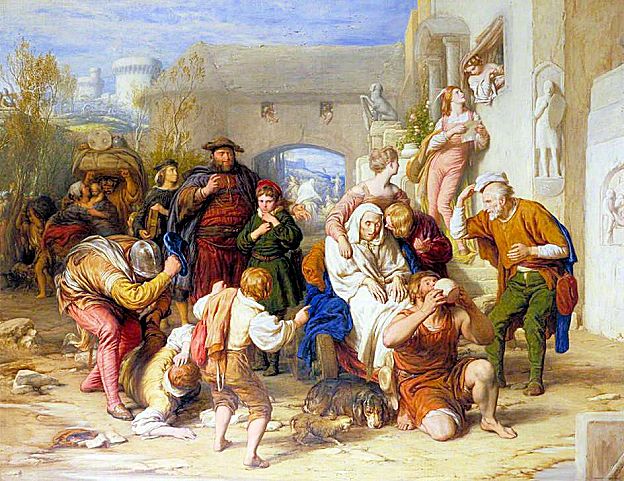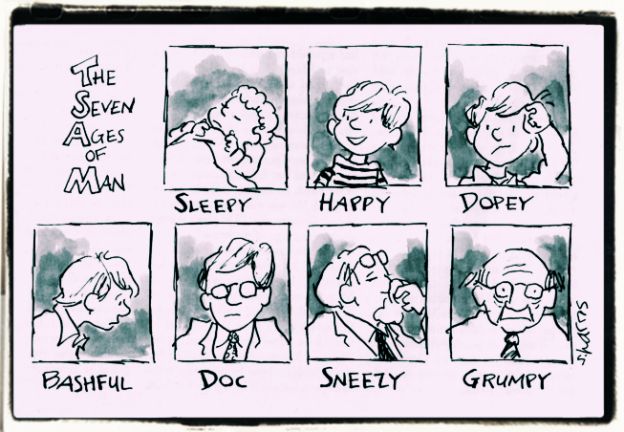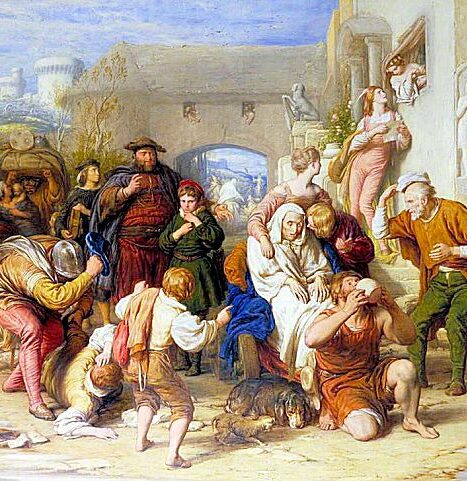
Seven ages of man, a poem by the great bard William Shakespeare and a very interesting short essay written by Alex Comfort an English gerontologist and author of many books.
The poem “The Seven Ages of Man” is a part of the play “As You Like It”, where Jacques makes a dramatic speech in the presence of the Duke in Act II, Scene VII. Through the voice of Jacques, Shakespeare sends out a profound message about life and our role in it.
Shakespeare’s Seven Ages of Man
All the world’s a stage,
And all the men and women merely players,
They have their exits and entrances,
And one man in his time plays many parts,
His acts being seven ages. At first the infant,
Mewling and puking in the nurse’s arms.
Then, the whining schoolboy with his satchel
And shining morning face, creeping like snail
Unwillingly to school. And then the lover,
Sighing like furnace, with a woeful ballad
Made to his mistress’ eyebrow. Then a soldier,
Full of strange oaths, and bearded like the pard,
Jealous in honour, sudden, and quick in quarrel,
Seeking the bubble reputation
Even in the cannon’s mouth. And then the justice
In fair round belly, with good capon lin’d,
With eyes severe, and beard of formal cut,
Full of wise saws, and modern instances,
And so he plays his part. The sixth age shifts
Into the lean and slipper’d pantaloon,
With spectacles on nose, and pouch on side,
His youthful hose well sav’d, a world too wide,
For his shrunk shank, and his big manly voice,
Turning again towards childish treble, pipes
And whistles in his sound. Last scene of all,
That ends this strange eventful history,
Is second childishness and mere oblivion,
Sans teeth, sans eyes, sans taste, sans everything.
In this drama of life, each one of us plays seven distinct roles. This, the author says, is the Seven Ages of Man. These seven roles begin at birth and end with death.

The Seven Ages of Man by Alex Comfort an English gerontologist and author, a very interesting article written 60 years ago that demonstrates how things have always been the same since biblical times, and this is even more true in this Coronavirus pandemic dramatic period.
One of the earliest, and perhaps most disturbing, things a human child has to learn is that the course of human life follows the clock – it can be predicted in advance. When he is twenty he will be grown up, when he is eighty he will be old, and before he is a hundred he will die. We take this for granted because we are familiar with it, just as we take for granted the fact that we have a characteristic size; we plan our lives in terms of it, just as we plan our houses, so that the few people who are more than 20 per cent taller or shorter than usual find them difficult to live in.
I suppose the main reason this fixed programme affects us emotionally is that it means we have a fixed life-span. After a certain age our vigour and resistance to disease will begin to get less and they will go on declining at a steady rate until some stress, which earlier in life we could have resisted, kills us. This is the process we call ageing. It is so statistically constant in man that insurance companies can guarantee us against early death, and we can roughly – though only very roughly – guess at the stage it has reached from a man’s personal appearance.
Fixity of life-programme, if I can call it that, and fixed adult size are two things which are typical of warm-blooded animals. In cold-blooded animals there is much less fixity, especially in relation to growth. Many fish, for example, have no characteristic adult size; and some of them may possibly have no characteristic adult life-span. But in every warm-blooded animal there is a set life-programme which is adapted to the way in which that sort of animal lives. There is a set period of development before birth, a set period of pre-adulthood, then sexual maturity, and then, in the larger animals, the beginning of a senile decline. In the wild state this decline is cut very short compared with our old age; small mammals like mice never reach it at all, for their accidental death rate is so high that the rise in it which we call ageing never has time to show itself. But the horses on stud farms and mice kept in the laboratory do show it; they age, in other words, roughly as we do, and their maximum life-spans are fixed.
The human life-programme has three things about it that are unique, and they are, in fact, the three biological characters which contain the whole of human development. They are the great length of the period of sexual immaturity and dependence on parent, the great length of the life span as a,whole – longer than that of any other mammal, and only approached by very much larger ones like the elephant and the rhinoceros – and the fact that in women, though not in men, reproduction ends definitely a long time before they become senile.

This pattern of the ages of man is unlike that of most other animals, though we can begin to see something like it developping in the higher apes. The most characteristic difference is in our pattern of early growth. Man is born helpless, like a kitten; he grows at about a typical rate for a warm-blooded animal up to the age of four or so. If he followed the same programme as a sheep or a puppy, then allowing for the different time-scale he would be sexually mature and fully independent at about nine years old. But instead his growth becomes slower, and a whole extra period of delayed growth and dependence on the mother is put into the growth curve, between the ages, roughly speaking, of four and twelve. Then the tempo suddenly quickens, growth and development become rapid, and adolescence leads on to sexual maturity.
This inserted period is one of the most important factors in making man behave as he does. It accounts for his long child-hood, his family pattern, which has been the basis of his society, and his ability to use conceptual thought, since this depends on learning and conditioning, instead of on simple instinct. At first sight it looks like a simple marking-time period, but if we look closer we can see that it also covers more radical changes. Human beings do not normally become able to breed until at least their teens. And sexual behaviour – that behaviour associated with breeding – appears in most mammals about the time that breeding itself becomes possible. We used to think that the same was true of ourselves, and when Freud began to draw attention to the existence of elaborate sexual impulses in early infancy he met with much scepticism. But today these impulses are generally recognized, and they are believed to play an important part in forming the adult character.
It looks then, very much as if, with the development of this marking time period in humans, a whole section of what, in lower animals, was purely reproductive impulse, has become isolated, as it were, pushed back into childhood, a long time before the human breeding age, and given a new function, connected this time with family behaviour and character structure.
The pattern of our development is fixed on the average, but it is not entirely fixed. It can be affected by circumstances – illnesses, injuries such as fears or frights, diet – and by inherited make-up. These things can affect for example, the age of puberty and the physical, social, and mental development that goes with it. So far as outside factors are concerned, the striking thing is the power of our timing-system to keep to keep to its programme – to catch up, for example, if physical development is checked by illness or hunger. Checks like these are followed by a growth rebound: the children who were starved during the last years of the war caught up in weight and development within the next two. But apart from outside factors there are constitutional variations which we are only just coming to recognize. And these are specially important because they affect performance in behaviour and in learning as well as bodily growth.
This question of rates of adolescent and childhood development is one on which much research is being done, and much more is needed. The results of such research may influence us a good deal in the future – in planning our schools, for instance. Some boys of twelve have the same physical and mental attainments as others of fifteen, even when their final performance is going to be the same: they are different not in intelligence or in ultimate physique but in pattern of development. And just as there are giants and dwarfs who diverge greatly from the normal size, so there are extreme cases in which the rate of development varies. The most interesting of these are the children, usually little girls, whose growth follows the same programme as that of a puppy or a sheep: it lacks the human period of slowing-down. At the age of nine these children have the physical development of a normal sixteen-year-old. This is not an illness but a family character, and they come to no harm from it; their life-span is normal and, more interesting still, the speed-up is selective. Their mental development, and the eruption of their teeth, follow the normal timing.

To some extent early or late maturing, we know, depends on body build. We study it by photographic and other measurements in children, and since we have to follow individuals, and not averages, it obviously takes a long time. One confusing thing is that the rate of development in all the privileged countries seems to be getting quicker. In England and northern Europe the age of sexual maturity in girls has come down by five years over the last century, and it is harder and harder to get choir-boys with treble voices. This probably means, I think, that in the last century puberty was delayed by bad social hygiene, and that it is now coming back to normal. But we would very much like to know what the clock mechanism is that times puberty. At present we do not know with certainty, though it appears to be in the brain. We would equally like to know the mechanism which causes sexual life in the female to end in middle age. Most of all, we would like to know the cause of that steady fall in vigour and rise in mortality which we call ageing.
The alchemists of the Middle Ages had three great ambitions. One was to transmute the elements; another one was to reach the Moon; and the third was to find the Elixir of Life, which would arrest the process of ageing and keep a man flied in his period of adult vigour. But magic gave place to soberer kinds of investigation: people realized that these were impossible projects and left them to charlatans and lunatics. The elements are being transmuted every day now in atomic piles; and the Russians have just put a rocket on the Moon. Technological problems like these, however, have an immense advantage over the third one, the Elixir of Life, because the conditions for success are, roughly speaking, known. In trying to alter the rate of ageing in man the requirements are not known, and the first problem is to discover them. But in the last few years we have seen the growth of a body of research in many different countries, which has the assignment of finding out if, and how, the rate of ageing in man can be controlled.
Ageing does not seem to be a simple accumulation of damage from all the knocks to which we are exposed: the rate at which it occurs is too constant for that. It may represent a special kind of damage. There are two obvious forms which this might take, bearing in mind that some cells in the body can be replaced indefinitely – skin cells, for example; and others – brain cells – not at all. Ageing might represent the progressive losing of irreplaceable cells, or it might be a change in the quality of replacements – in other words, an increasing number of faults in the copying process. The chief hope of controlling ageing has always lain in the possibility that it was timed by one main change. When hormones were discovered, it was hoped that these might possibly control the loss of vigour: that hope has been largely disappointed, though hormones can be used to control parts of the ageing process. Perhaps the main reason for hoping we shall be able to control, or at least modify, the whole of it, whatever its cause, is the fact that in rats, ageing can be made to mark time, as it were, by slowing down their development. Underfed rats can be kept juvenile and fully active for the length of a whole rat lifetime, and if they are then fed they grow up, develop, and live, in all, twice as long as normal rats.
Ageing, then, in the rat at least, is linked to the developmental clock. It may be in man, but it is much more difficult to know yet whether we can tamper with the clock. By under feeding immature rats we are effectively doing what happens already from natural causes in man – we are putting a long delay in childhood. There are other ways in which we might possibly control ageing: if faulty copying of cells plays a part, ageing might be arrested or slowed by some drugs which protect the cell’s copying mechanism against other kinds of damage – that caused by radiation for example.

Man is lengthening his effective life all the time by cutting down deaths during its early part. But so far he has no way of lengthening his normal maximum life: it is still about four-score years, as it was in biblical times. Medicine has made rather little impression on this part of the curve of survival: failure occurs so rapidly towards the end that every old man who dies of one cause has generally several causes present which would have killed him if that one had not. It is this problem, the problem of altering the whole time-scale and slowing down the process of decline which gerontology – the study of old age – is now attempting to tackle. Whether and how far it will succeed we do not yet know. My guess is that it may eventually produce a substantial increase in life-span, but not, I am afraid, for a long time.
In the riddle which the Sphinx put to Oedipus the clues to the answer, Man, were that he is an animal that goes first on four legs, then on two legs, then on three – crawling, walking, leaning on a stick. We should say now, I think, that he is an animal that is born very immature, has a long period of child-hood dependence, displays infantile sex behaviour which has an important function in mind-development, lives in social communities based on the family, and has used the power of conceptual thought to protect himself so that he can reach his old age. Bearing in mind that the story of Oedipus has itself an important connexion with the psychological part of this development, I think that, in anticipating modern human biology, the Greek insight into the nature of Man was really remarkably accurate.
In Greek mythology the Sphinx was a monster that asked people riddles and killed those who could not answer them. The actual riddle that the Sphinx put to Oedipus was: ‘What is it that walks on four legs in the morning, on two at noon, on three in the evening?’ When Oedipus gave the right answer the Sphinx killed itself.
Alex Comfort, byname of Alexander Comfort, (born Feb. 10, 1920, London, Eng.—died March 26, 2000, Banbury, Oxfordshire), English gerontologist and author, best known for his books on sexual behaviour.
Comfort’s theories on aging are expressed in The Biology of Senescence (1956) and The Process of Aging (1964), the latter being an introduction to gerontology for the layperson. He advocated greater freedom in sexual behaviour in books ranging from the scholarly Sexual Behaviour in Society (1950) to the best-selling The Joy of Sex (1972), which was described as a “gourmet guide to lovemaking” and featured unself-conscious text and illustrations. Translated into more than 20 languages, it was followed by More Joy of Sex (1974) and The New Joy of Sex (1991). Among Comfort’s other books on sexual problems and practices are Sex in Society (1975) and Sexual Consequences of Disability (1978).

